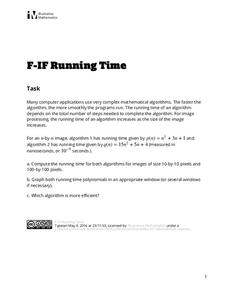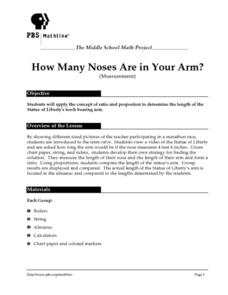Curated OER
How Much Does it Cost to Light Your School?
Learners compute the cost of electricity used to light their classroom and their school for various lengths of time. They compute the amount of coal needed to produce the electricity used for one hour of light in their classroom. An...
Alabama Learning Exchange
Comparing Fuel Economy
Compute fuel economy and gas mileage. Why? So you can teach rates and ratios, of course! Middle schoolers calculate the rate of miles per gallon for various vehicles. They research each vehicle, its mileage per gallon, and cost per...
Illustrative Mathematics
Exponentials and Logarithms I
This task focuses on using the verbal definition of the logarithm to understand that a logarithm is an exponent. Learners complete six computational exercises using the inverse properties of logs and exponents and answer two...
Curated OER
It Takes Ten
Review and use standard units of measure with your math class. They move from station to station estimating and measuring length, volume, weight, and area. At each station they estimate and measure, and then compute the difference...
Illustrative Mathematics
Voting for Three, Variation 2
Here is another opportunity for math students to apply reasoning to solve real-world problems with ratios. The ratio of the number of votes for two candidates is provided. Your class is asked to use this ratio and information given about...
Curated OER
Measuring Speed With iMovie
Students record each other running, walking, throwing a ball, or doing a similar activity for a set distance. They import the video clips into iMovie. They compute how long it took in miles per hour.
Curated OER
Principles of Square Roots Lesson Plan
Middle and high schoolers investigate all the different places in math that square root is present. In this geometry lesson plan, pupils discuss square roots as it relates to a right triangle and construction. They go over altitude,...
Curated OER
Lesson Design Protocol: Add and Subtract
Addition and subtraction are studied in this math lesson. Upper graders add and subtract whole numbers up to 1,000 with and without regrouping.
Achieve
Yogurt Packaging
Food companies understand how to use math to their advantage. Learners explore the math related to the packaging and serving size of yogurt. They then use unit analysis and percent values to make decisions on the product development.
PBL Pathways
Lake Pollution
Explain the timing of a lake cleanup to the EPA using calculus. A project-based learning opportunity has learners compare rate functions to compute a total change. Their solutions explain the time needed to rid a lake of pollutants.
Illustrative Mathematics
Half of a Recipe
Kids love to cook! What is a better place to learn mixed numbers than with a recipe? It is up to learners to decide how they want to divide this recipe in half. They may choose to model the mixed number and then divide the model by two....
Illustrative Mathematics
Running to School, Variation 3
How far is it between school and home? Here is a relatable activity where the participant runs to school a certain fraction of the way. That distance is given in miles. It is up to your learners to determine the distance between home and...
Illustrative Mathematics
Drinking Juice, Variation 2
An excellent activity using word problems where pupils interpret and compute quotients of fractions. The commentary includes using a fraction bar model and equations to represent the problem. In this variation of the resource, the...
Curated OER
Rating Systems
Your favorite sports team is ranked #1. How do the powers that be determine this rating? Learn how ratings are mathematically computed using probability concepts, from the Elo Rating System for chess to the Rating Percentage Index for...
Illustrative Mathematics
Sounds Really Good! (Sort Of...)
Winning a lottery game with 60% odds sounds like a no brainer. This is when the math kicks in to show players that in the long run, they lose money the more often they play. Here is one simple question that opens the doors to a nice...
Illustrative Mathematics
Running Time
Ever wonder why that computer image takes so long to load? Well, math is involved and provides the algorithms needed to compute the measure in nanoseconds. Young mathematicians plug the image measures into the formulas and compare the...
Curated OER
How Many Noses Are in Your Arm?
Middle schoolers apply concept of ratio and proportion to determine length of Statue of Liberty's torch-bearing arm. They view video of Statue of Liberty, determine how long statue's arm would be if its nose measures four feet six...
Curated OER
Mirror, Mirror
Geometry students use hinged mirrors to discover that the regular polygons are composed of triangles tessellating around a center point. They sketch triangles on paper models of the regular polygons having 3 to 10 sides and compute the...
Raytheon
Signed Numbers/Integers Worksheets
In this positive and negative numbers activity, middle schoolers compute the values indicated using addition, subtraction, multiplication and division, with answer keys included.
Agile Mind
Isabella’s Credit Card
An in-depth activity that involves a real-world problem about credit card debt. Learners are given a scenario in which Isabella plans to stop using her credit card and pay off the balance by paying a fixed amount each month. The first...
National Research Center for Career and Technical Education
Transportation, Distribution, and Logistics: Tire and Wheel Assemblies
Is bigger really better? By the end of this instructional activity, learners will be able to apply formulas for computing the diameter of tires and wheel assemblies. Begin by showing a slide presentation that will review definitions for...
Bridges In Mathematics
Kindergarten Assessments and Scoring Checklists, Common Core State Standards
Whether or not your school has adopted Common Core standards, this resource provides great tools for assessing kindergartners' key numeracy and computation skills.
MathMovesU
Negative Numbers Practice
A collection of nine integer worksheets, middle schoolers practice computing the positive and negative values in a variety of problems. Adding, subtracting, multiplying, and dividing integers are the skills conveyed in these resources.
Concord Consortium
Calculator Numbers
Know thy calculator. Young mathematicians use their calculators to answer a set of questions. They consider how the number of digits the calculator displays affects the answers to calculations. They then find examples of computations...























